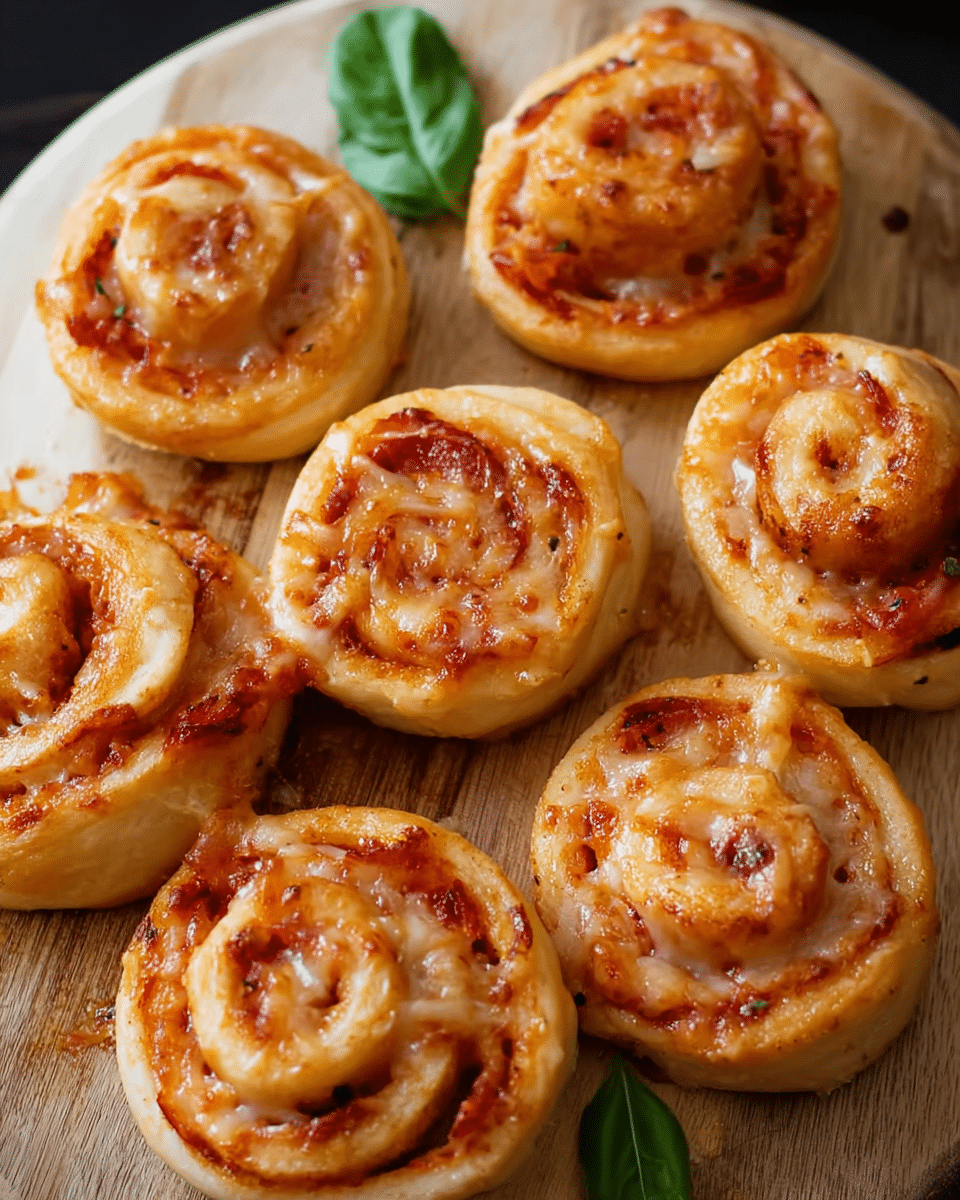These Pizza Rolls are the perfect balance of soft, buttery dough and gooey, cheesy goodness. Made with crescent roll dough for convenience, they’re an ideal snack or quick meal that’s ready in under 30 minutes. The melted mozzarella, tangy pizza sauce, and savory pepperoni make every bite irresistible.
Best of all, this recipe is incredibly versatile switch up the cheese, use your favorite toppings, or make them veggie loaded for a healthier twist. They’re perfect for game day, after-school snacks, or even a fun dinner that gets everyone gathered around the table. Serve them fresh from the oven with a side of warm marinara for dipping, and watch them disappear.
Full Recipe:
Ingredients:
-
1 can refrigerated crescent roll dough (Trader Joe’s or preferred brand)
-
1/2 cup pizza sauce or plain tomato sauce
-
1 cup shredded mozzarella cheese (or cheese of choice)
-
1/2 cup mini pepperoni slices (optional)
-
1/2 teaspoon Italian seasoning
-
1 tablespoon olive oil (optional, for brushing)
Directions:
-
Preheat oven to 375°F (190°C) and line a baking sheet with parchment paper.
-
Unroll the crescent dough onto a clean surface and gently press seams together to form a rectangle.
-
Spread pizza sauce evenly over the dough, leaving a 1/2-inch border.
-
Sprinkle mozzarella cheese evenly, followed by pepperoni slices if using.
-
Lightly sprinkle Italian seasoning over the top.
-
Starting from the longer side, roll the dough into a tight log.
-
Slice into 8–10 equal pieces and place cut side down on the prepared baking sheet.
-
Brush tops with olive oil for extra golden color.
-
Bake for 12–15 minutes, or until golden brown and cheese is bubbly.
-
Serve warm with extra pizza sauce for dipping.
Prep Time: 10 minutes | Cooking Time: 15 minutes | Total Time: 25 minutes
Kcal: 160 kcal per roll | Servings: 8–10 rolls
The Comforting Charm of Homemade Pizza Rolls
Few foods strike the perfect balance between nostalgia, convenience, and pure indulgence quite like pizza rolls. For many of us, the name alone brings back memories of after-school snacks, game nights, or the occasional “lazy dinner” that still somehow feels special. While the freezer aisle version has long been a staple in busy households, nothing beats the satisfaction of making them yourself at home.
These homemade pizza rolls take everything we love about the classic crispy edges, gooey cheese, savory sauce and elevate it with fresher flavors, customizable fillings, and the cozy smell of baking that fills your kitchen. They’re warm, cheesy, handheld, and endlessly versatile. And the best part? They’re just as quick and easy to whip up as they are to devour.
Why Make Pizza Rolls at Home?
Let’s be honest pizza rolls have always been about fun. They’re the food equivalent of a party trick: easy to share, easy to eat, and guaranteed to make everyone smile. But store-bought versions often come with drawbacks: excessive sodium, preservatives, and a texture that can veer from soggy to rock-hard depending on how they’re cooked.
When you make them at home, you have total control over every element. You choose the dough whether it’s a convenient refrigerated crescent roll, biscuit dough, or even your own homemade pizza dough. You decide how much cheese to load in (or how much restraint to exercise, though honestly, restraint is overrated here). And you can swap in your favorite toppings, from classic pepperoni to sautéed mushrooms, roasted veggies, or even something unconventional like barbecue chicken.
The Role of the Dough
One of the defining features of a great pizza roll is the crust it should be tender on the inside, lightly crisp on the outside, and strong enough to hold the filling without bursting. Crescent roll dough is a favorite choice for home cooks because it bakes up golden and flaky with minimal effort. It also has a subtle buttery flavor that pairs beautifully with the tang of pizza sauce and the richness of melted cheese.
That said, there’s room to experiment. Biscuit dough creates a thicker, heartier bite, while homemade pizza dough brings a chewier, more traditional crust. Some people even use puff pastry for an extra-light, shatteringly crisp texture. The type of dough you choose will slightly change the baking time and final mouthfeel, but each has its own charm.
Sauces: Beyond the Basic
While classic marinara or pizza sauce is the go-to choice, homemade pizza rolls are the perfect opportunity to get creative with your base layer. Imagine slathering the dough with a garlic-Parmesan cream sauce for a white pizza roll, or adding a layer of pesto for a fresh, herbal twist. Barbecue sauce, buffalo sauce, or even a smoky chipotle tomato sauce can transform the flavor profile entirely.
If you prefer a lighter touch, you can use less sauce and rely more on the moisture from the cheese and toppings. Just remember: too much sauce can cause your rolls to leak or become soggy in the middle, so moderation is key.
Cheese: The Heart of the Roll
There’s a reason “cheese pull” videos are so mesmerizing melted cheese is pure magic. Mozzarella remains the undisputed champion for pizza rolls, thanks to its melty, stretchy quality and mild flavor that plays well with others. But adding a second cheese can take things to the next level.
Consider blending in a little sharp cheddar for tang, provolone for depth, or even crumbles of feta for a Mediterranean spin. For spice lovers, pepper jack cheese can add just enough kick to keep things interesting. Whatever cheese you choose, shred it yourself if possible pre-shredded cheese often contains anti-caking agents that can hinder smooth melting.
Fillings That Go Beyond Pepperoni
Pepperoni is the timeless choice for a reason it’s flavorful, easy to work with, and delivers that classic pizza taste. But once you start experimenting, the possibilities are endless:
-
Vegetarian delights: sautéed spinach, caramelized onions, roasted peppers, mushrooms, or artichoke hearts.
-
Protein-rich: cooked sausage, shredded rotisserie chicken, crumbled bacon, or even diced ham.
-
International twists: teriyaki chicken with pineapple, Mediterranean-inspired rolls with olives and feta, or taco-seasoned beef with cheddar and salsa for dipping.
The key is to keep fillings finely chopped and relatively dry to prevent excess moisture from seeping into the dough.
The Baking Process: From Prep to Golden Perfection
The magic of pizza rolls happens in the oven, where the dough transforms into golden pillows that are crisp on the outside and tender within. A hot oven ensures quick puffing and even browning. For extra appeal, brushing the tops with olive oil or an egg wash before baking helps them achieve that irresistible sheen and slight crunch.
If you’re making a large batch, consider rotating the baking sheet halfway through for even cooking. And always give the rolls a minute or two to cool before serving this not only prevents burned tongues but also allows the cheese to set slightly, making them easier to handle.
Serving Suggestions
Pizza rolls shine as a snack or appetizer, but they can also be the star of a casual dinner when paired with a fresh salad or a bowl of soup. Serve them with extra sauce on the side for dipping marinara is classic, but ranch dressing, garlic butter, or even a spicy aioli can be delightful.
For parties, try making a platter with different filling combinations so guests can sample a variety. And for kids’ lunches, cooled pizza rolls packed in a lunchbox with a small container of dipping sauce are sure to win the day.
Storage and Reheating
Homemade pizza rolls store surprisingly well, making them a great make-ahead option. Once cooled, you can refrigerate them for up to three days or freeze them for longer storage. To reheat, use an oven or air fryer to restore their crisp edges—microwaving works in a pinch but can make the dough soft.
If freezing, arrange the rolls on a baking sheet in a single layer until firm, then transfer to a freezer bag. This prevents them from sticking together and allows you to pull out just the amount you need.
Customizing for Dietary Needs
One of the biggest advantages of homemade pizza rolls is the ability to tailor them to specific dietary preferences. Gluten-free dough options are widely available for those avoiding wheat, and dairy-free cheeses melt better than ever thanks to improvements in plant-based products. You can also easily make vegetarian or vegan versions by swapping meat for vegetables and using non-dairy cheese.
For a lower-carb approach, you might use almond flour dough or a cauliflower-based crust rolled thin, though the texture will differ from traditional pizza rolls.
The Social Side of Pizza Rolls
Pizza rolls have a way of bringing people together. They’re a communal food perfect for placing on the table and letting everyone grab a piece. Whether it’s a casual family dinner, a holiday gathering, or an intense game-day spread, pizza rolls have the kind of universal appeal that bridges generations and tastes.
They also lend themselves beautifully to food styling and photography, making them ideal for sharing on social media. That gooey cheese stretch? Instant likes. The golden crust? Pure food envy.
Conclusion:
Homemade pizza rolls are proof that simple ingredients and straightforward techniques can yield something truly special. They embody the fun, relaxed spirit of pizza but in a more playful, bite-sized format. The ease of preparation means they’re just as suited to a weeknight treat as they are to a party spread.
Most importantly, they invite creativity every choice you make, from the dough to the sauce to the filling, shapes the flavor experience. And while they’re undeniably a comfort food, making them yourself ensures you’re serving something fresher, tastier, and made with care.
So next time you’re craving that familiar cheesy, saucy goodness, skip the freezer box and roll up a batch yourself. Your kitchen will smell incredible, your guests (or family) will thank you, and you might just find this simple recipe becoming one of your go-to favorites.






